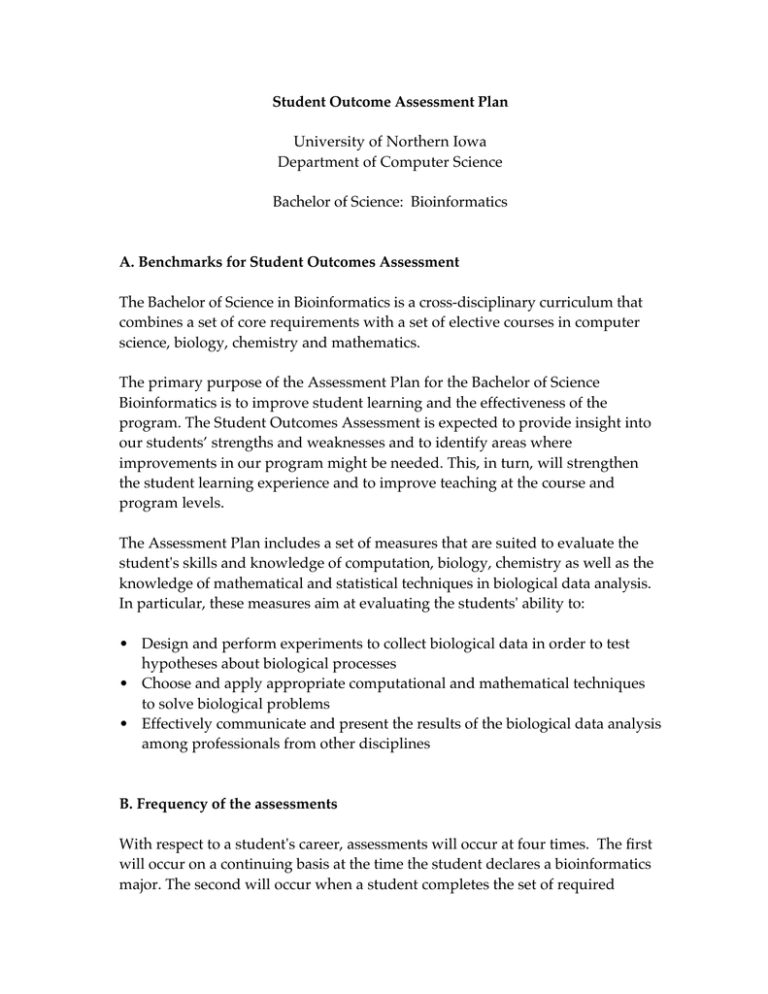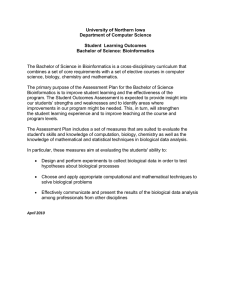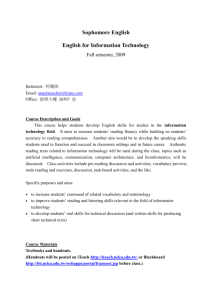Student Outcome Assessment Plan A. Benchmarks for Student Outcomes Assessment
advertisement

Student Outcome Assessment Plan University of Northern Iowa Department of Computer Science Bachelor of Science: Bioinformatics A. Benchmarks for Student Outcomes Assessment The Bachelor of Science in Bioinformatics is a cross-disciplinary curriculum that combines a set of core requirements with a set of elective courses in computer science, biology, chemistry and mathematics. The primary purpose of the Assessment Plan for the Bachelor of Science Bioinformatics is to improve student learning and the effectiveness of the program. The Student Outcomes Assessment is expected to provide insight into our students’ strengths and weaknesses and to identify areas where improvements in our program might be needed. This, in turn, will strengthen the student learning experience and to improve teaching at the course and program levels. The Assessment Plan includes a set of measures that are suited to evaluate the student's skills and knowledge of computation, biology, chemistry as well as the knowledge of mathematical and statistical techniques in biological data analysis. In particular, these measures aim at evaluating the students' ability to: • Design and perform experiments to collect biological data in order to test hypotheses about biological processes • Choose and apply appropriate computational and mathematical techniques to solve biological problems • Effectively communicate and present the results of the biological data analysis among professionals from other disciplines B. Frequency of the assessments With respect to a student's career, assessments will occur at four times. The first will occur on a continuing basis at the time the student declares a bioinformatics major. The second will occur when a student completes the set of required courses in the major. The third assessment will occur at the time of the graduation. The post-graduation assessment will occur biennially. B. Procedures. The current SOA plan uses four difference assessment instruments: (i) Declaration Survey At major declaration time students are required to complete a questionnaire (see Appendix A) addressing their reasons for selecting the bioinformatics major, career goals, and previous background. Until this questionnaire is completed, their "Declaration of Major Form" is not forwarded to the Registrar. Additional materials such as ACT scores, high school GPA, high school rank, and a current transcript are collected at this time. The purpose of this stage of the assessment is to aid the computer science faculty in understanding the background of our students and perceptions of the field. This information might enable the faculty to find some success indicators for the program. (ii) Student Outcomes Assessment Test This comprehensive test is administered to test student proficiency in subjects taught in the required bioinformatics courses: Calculus I (800:060), Introductory Statistics for Life Sciences (800:064), Introduction to Computing (810:051), Discrete Structures (810:080), Computing for Bioinformatics I (810:165), Computing for Bioinformatics II (810:166), General Biology: Cell Structure and Function (840:052), Bioinformatics Applications to Biology (840:127), Genetics (840:140), General Chemistry I-II (860:070, or both 860:044 and 860:048), Applied Organic and Biochemistry (860:063) or Organic Chemistry I (860:120). The primary mechanism for conducting assessment of the computer science knowledge and skills is the software package PAT (Program Assessment Tool). PAT will administer the test, summarize the results, compare them against the departmental expectations for each subject and generate the reports. (iii) Exit surveys Each semester during the last week of classes, students in the program will take a blind (anonymous) survey that rates their perceived understanding of each topic using a low, mediumlow, medium, meduimhigh, and high scale (see Appendix A). (iv) Alumni Surveys Every two years a survey of recent graduates is conducted. The questionnaire (see Appendix A) is designed to assess strengthens and weaknesses in the preparation received during the program. Appendix A Student Outcome and Assessment Forms Department of Computer Science Bioinformatics Major Declaration Survey Name ________________________ Date ____________ Background: What computer science and biology courses did you take before coming to UNI? Where did you take the courses? What computer science and biology courses did you take at UNI? Did any of these courses influence your decision to become a bioinformatics major? Which courses? Objectives Essay: Write a short essay on your career objectives on the back of this page. Address the following questions and include anything else you consider appropriate. 1. Why did you choose bioinformatics? 2. What do you expect to do directly after earning your degree? 3. What do you expect to be doing five years after earning your degree? Note: Your major declaration will not be forwarded to the registrar's office until you return this completed form. Exit Survey This section lists some of the most important topics in the bioinformatics program at UNI. Rank your understanding of the topics according to the descriptions of None, Low, Medium, Med/High, and High at the top of the page on the back of this survey. Topic None Watson and Crick model of DNA Central Dogma of molecular biology General transfer of biological sequential informatio n DNA replication Transcripti on Translation Genes, introns and exons How the informatio n is “expressed ” in the form of RNA and proteins Low Medium Med/High High Three types of protein structure: primary, secondary and tertiary Key concepts in bioinforma tics and the ways in which bioinforma tics can contribute to scientific informatio n and practice Human genome project Main bioinforma tics resources on the Web Protein and DNA sequence and structure databases SWISSPROT, nr, PDB databases Software Hydrogen tools used in bioinforma tics BLAST, PSI-BLAST Chemical structure of nucleotides Chemical structure of ribonucleic acid Chemical structure of deoxyribo nucleic acid Chemical differences between DNA and RNA molecules Physical differences between DNA and RNA molecules The notion of nucleotide base pairing Computin Hydrogen bonding g the probability The role of of an event DNA as using the the basic repository definition of genetic of informatio n The triplet code The role of m-RNA in protein synthesis The chemical structure of amino acids The peptide bond formations and protein structure Basic concepts in probability and statistics Algorithms Computin g the for probability constructin ofDNA g an event using the basic definition of probability Random variable Probability distributio ns Binomial distributio n Normal distributio n Statistical significance of protein and DNA sequence alignment scores Z-score p-value and Evalue DNA restriction mapping problem Substitutio Algorithms formatrices, n constructin g DNA restriction maps Combinato rial pattern matching algorithms Regulatory motifs in DNA sequences Median strings The difference between the bruteforce and branchand-bound approaches to finding regulatory motifs and median strings in DNA sequence The importance of string compariso n in bioinforma tics Substitutio n matrices, PAM series, BLOSUM series SmithWaterman alignment algorithm Needlema n-Wunsch alignment algorithm Alignment s with gaps Different types of gap penalties, linear, affine, position specific Multiple sequence alignment Scoring multiple sequence alignment Protein structural alignment Protein threedimension al structure prediction Statistical approaches to gene prediction Similaritybased approaches to gene prediction Graph algorithms for DNA sequencing Sequencing by hybridizati on (SBH) SBH as a Hamiltonia n path problem vs. SBH as an Eulerian path problem Hierarchica l clustering k-means clustering Evolutiona ry trees UPGMA algorithm Neighborjoining algorithm Small parsimony problem Large parsimony problem Hidden Markov models in biological sequence analysis Computati onal complexity , big-O notation Time complexity of bioinforma tics algorithms, e.g. the dynamic programm ing for sequence alignment Bioinformatics Alumni Survey As one mechanism to evaluate the Bioinformatics program at UNI and to gather information to use in curriculum revision, please complete and return the following short survey. Please feel free to add additional comments on the back of this sheet. Rate the following on a scale from 1 (poor) to 5 (excellent): How well did UNI Bioinformatics program prepare you: ____ to learn to work in your current work environment? ____ to use the bioinformatics software tools? ____ to work in a team? ____ to give oral presentations? ____ to give written presentations? ____ for your first job (or graduate school)? What do you suggest be added to the UNI Bioinformatics curriculum to improve our students' transition into the work place? Name of your current employer or graduate school. (Optional) Your name, current address, email address, and telephone number. (Optional)







